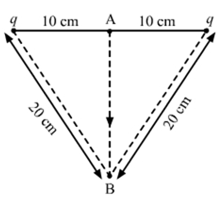Two equal charges, 2.0 × 10–7 C each, are held fixed at a separation of 20 cm. A third charge of equal magnitude is placed midway between the two charges. It is now moved to a point 20 cm from both the charges. How much work is done by the electric field during the process?
Given:
Magnitude of all three charges: q1=q2=q3= q= 2.0 × 10–7 C
Separation between first two charges: d = 20 cm = 0.2m
From the figure,
Distance between charge at A and both the charges:
r =10cm= 0.1 m
Distance between charge at b and both the charges:
r’= 20 cm= 0.2 m
Formula used:
Potential is given as![]() Here, Here, k is a constant and k=
Here, Here, k is a constant and k= ![]() =9× 109 Nm2C-2 . q is the point charge and r is the distance between the charge and the point of influence.
=9× 109 Nm2C-2 . q is the point charge and r is the distance between the charge and the point of influence.
Since A is midway between two point charges, potential at A will be due to both the charges:![]()
![]()
![]() Now, when charge at A is displaced to B, potential difference is created. Potential at B is due to both the charges at 0.2 m equally from B.
Now, when charge at A is displaced to B, potential difference is created. Potential at B is due to both the charges at 0.2 m equally from B.
Potential at B:![]()
![]()
![]() Thus, Potential difference is:
Thus, Potential difference is:
VA-VB =36000-18000
∴ VA-VB = 18000
Work done is:
W= (VA-VB) × q
∴ W = 18000 × 2.0 × 10-7
∴ W = 3.6 × 10-3 J
Hence, 3.6× 10-3 J of work is being done by the electric field during whole process.